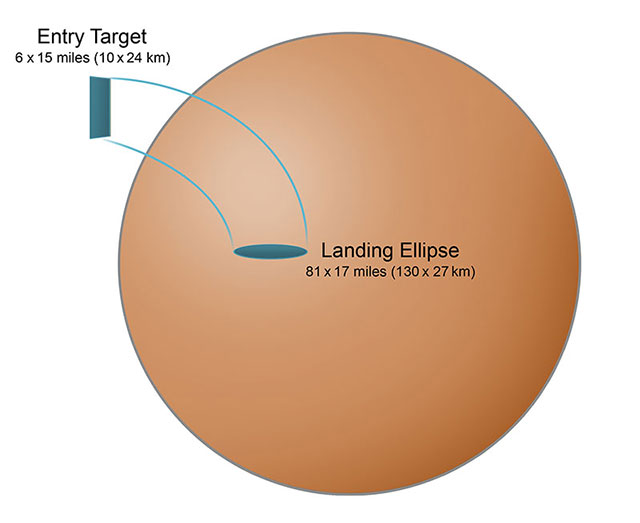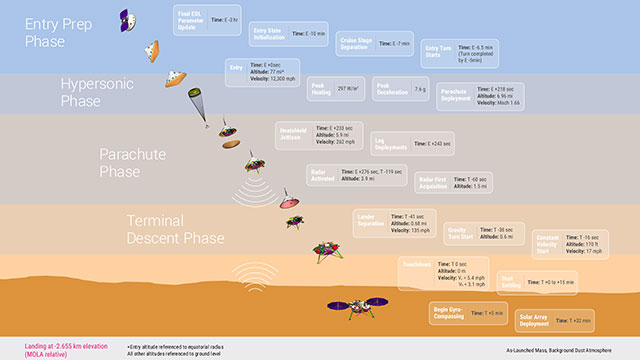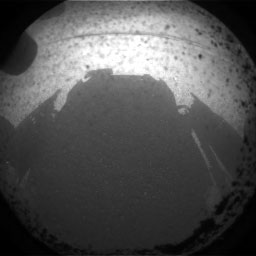Into the Atmosphere
Landing on Mars is an entirely automated process. But up until three hours before entering the Martian atmosphere, a team of engineers works to program the landing based on a variety of conditions. Daily weather updates from NASA’s Mars Reconnaissance Orbiter inform a team of EDL engineers who program InSight to complete each step of the landing process at a specific time. The times below are what the team expects as of October 2018. These times may shift depending on unexpected changes or environmental conditions.
The times also mark the moments when the spacecraft team expects to hear about a milestone, so they include the 8.1 minutes it takes to transmit a signal back from Mars. These times do not include the short, but increasing, delay in transmission that will come from the signals going into and out of the MarCO spacecraft on their way back to Earth.
At around 11:41 a.m. PST (2:41 p.m. EST), InSight will begin pivoting to put its heat shield face forward. Six minutes later, InSight will start sensing the top of the atmosphere. Before the parachute is deployed, friction between the atmosphere and the heat shield will remove nearly 99.5 percent of the entry vehicle’s kinetic energy. Peak heating will occur approximately 1.5 minutes after atmospheric entry, at around 11:49 a.m. PST (2:49 EST). The temperature at the external surface of the heat shield will reach about 2,700°F (about 1,500°C).
Peak deceleration will happen about 15 seconds later, at up to 7.5 g (greater than seven times the force of gravity at Earth’s surface). At this time, ionization of gas around the spacecraft from the intense heating may cause a temporary gap in the receipt of radio transmission from InSight.
InSight will continue to descend until the proper velocity and deceleration trigger conditions are met to deploy the parachute from the back shell. This is expected at approximately 11:51 a.m. PST (2:51 p.m. EST), at about 6.9 miles (11.1 kilometers) above ground level, at a velocity of about 861 mph (about 385 meters/sec). The anticipated load on the parachute when it first opens is about 12,500 pounds of force (55,600 newtons). Approximately 10 seconds after parachute deployment, electronics in the spacecraft’s landing radar will be powered on to warm up, and an auxiliary battery will be activated to supplement the lander’s main battery during critical current-drawing events of the next few minutes.

Parachute testing for InSight, conducted inside world's largest wind tunnel, at NASA Ames Research Center, Moffett Field, California. Download image
The spacecraft will descend on the parachute for about two minutes. During the first 25 seconds of parachute descent, InSight will jettison its heat shield and extend its three legs. About two minutes after the parachute opens and one minute before landing, the spacecraft will start using its radar to sense velocity and the distance to the ground.
Descent speed will have slowed to about 134 mph (60 meters per second) by the time the lander separates from the back shell and parachute, about two-thirds of a mile (1 kilometer) above the ground and about 45 seconds before touchdown. By design, the separation is triggered by radar sensing of altitude and velocity. A brief pause in communication is anticipated as data transmission shifts from the wrap-around antenna on the back shell to a helical UHF transmitter on the lander.

Illustration of InSight descending toward Mars with its retrorockets firing.
Slowing for Touchdown
One second after lander separation, the 12 descent engines on the lander will begin firing. Guidance software onboard for the terminal descent will provide commands for aligning the direction of thrust to the direction the spacecraft is moving, so the thrust will counter horizontal movement as well as decelerate the descent. If the spacecraft senses that its horizontal speed is below a threshold set in the software, it will also perform a maneuver to avoid the back shell that is still descending on its parachute. This maneuver would adjust the direction of thrust to reduce the chance that the back shell and parachute could land too close to the lander after the lander’s touchdown. The spacecraft will rotate to land in the desired orientation: with solar arrays extending east and west from the deck and the robotic arm’s work area on the south side of the lander.
InSight is still traveling at 17 mph (7.7 meters per second) 164 feet (50 meters) above the ground when it transitions to constant velocity mode in preparation for soft touchdown. Approximately 15 seconds later, the vehicle will touchdown with a velocity of 5 mph (2.24 meters per second).
The local solar time at the landing site in the Elysium Planitia area of Mars will be about 2 p.m. at touchdown (which will be about 11:54 a.m. PST, or 2:54 p.m. EST). If it is a relatively clear day -- no dust storm -- the forecast calls for air temperature at the height of the lander deck to reach about 18°F (minus 8°C) that afternoon and plummet to about minus 140°F (minus 96°C) overnight. The time of year in Mars’ northern hemisphere will be about midway between the autumn equinox and winter solstice.
The Martian day, or sol, of the landing will count as Sol Zero of InSight’s Mars surface operations.
Uncertainties in EDL Timing
While this is the InSight team’s best estimate for landing times, the exact times may change before landing day. Additional trajectory correction maneuvers -- along with atmospheric conditions that change when certain EDL events happen -- could shift the timeline slightly.













